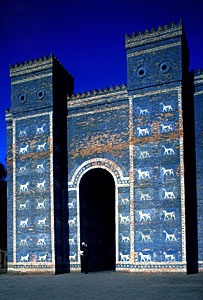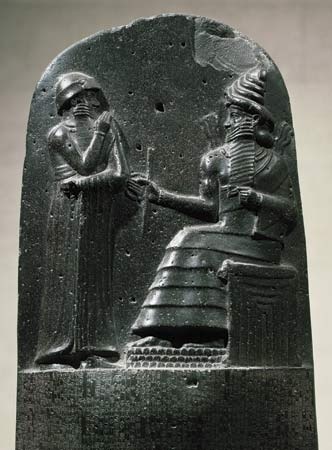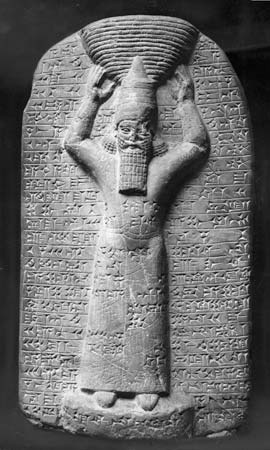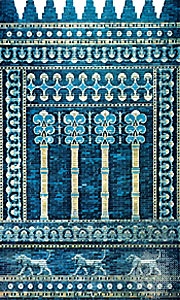Babylon
New York, United States
town (township), Suffolk county, southeastern New York, U.S. It lies on southern Long Island, along Great South Bay, east of Freeport. Established in 1872 after separation from Huntington (founded 1653), it includes the villages of Babylon (incorporated 1893), Amityville (1894), and Lindenhurst (1923) and the unincorporated communities of Deer Park, Copiague, and Wyandanch. The Italian inventor Guglielmo Marconi (Marconi, Guglielmo) erected (1902) the first wireless station in the United States (preserved at Rocky Point) at Babylon village, and Lawrence Sperry (son of inventor Elmer Sperry) experimented with early guided missiles at Amityville in 1918.
The town developed as a summer yachting resort but experienced rapid population and diversified industrial growth after World War II. Its economy is based on services. The State University of New York (New York, State University of (SUNY)) at Farmingdale (1912) and the Long Island campus (1964) of Polytechnic University are located nearby. Area 53 square miles (136 square km). Pop. (1990) 202,793; (2000) 211,792.
ancient city, Mesopotamia, Asia
Introduction
Babylonian Bab-ilu, Old Babylonian Bāb-ilim, Hebrew Bavel or Babel, Arabic Aṭlāl Bābil
 one of the most famous cities of antiquity. It was the capital of southern Mesopotamia (Mesopotamia, history of) ( Babylonia) from the early 2nd millennium to the early 1st millennium BC and capital of the Neo-Babylonian (Chaldean) empire in the 7th and 6th centuries BC, when it was at the height of its splendour. Its extensive ruins, on the Euphrates River about 55 miles (88 km) south of Baghdad, lie near the modern town of Al-Ḥillah (Ḥillah, Al-), Iraq.
one of the most famous cities of antiquity. It was the capital of southern Mesopotamia (Mesopotamia, history of) ( Babylonia) from the early 2nd millennium to the early 1st millennium BC and capital of the Neo-Babylonian (Chaldean) empire in the 7th and 6th centuries BC, when it was at the height of its splendour. Its extensive ruins, on the Euphrates River about 55 miles (88 km) south of Baghdad, lie near the modern town of Al-Ḥillah (Ḥillah, Al-), Iraq.History
 Though traces of prehistoric settlement exist, Babylon's development as a major city was late by Mesopotamian standards; no mention of it existed before the 23rd century BC. After the fall of the 3rd dynasty of Ur, under which Babylon had been a provincial centre, it became the nucleus of a small kingdom established in 1894 BC by the Amorite king Sumuabum, whose successors consolidated its status. The sixth and best-known of the Amorite dynasts, Hammurabi (1792–50 BC), conquered the surrounding city-states and raised Babylon to the capital of a kingdom comprising all of southern Mesopotamia and part of Assyria (northern Iraq). Its political importance, together with its favourable location, made it henceforth the main commercial and administrative centre of Babylonia, while its wealth and prestige made it a target for foreign conquerors.
Though traces of prehistoric settlement exist, Babylon's development as a major city was late by Mesopotamian standards; no mention of it existed before the 23rd century BC. After the fall of the 3rd dynasty of Ur, under which Babylon had been a provincial centre, it became the nucleus of a small kingdom established in 1894 BC by the Amorite king Sumuabum, whose successors consolidated its status. The sixth and best-known of the Amorite dynasts, Hammurabi (1792–50 BC), conquered the surrounding city-states and raised Babylon to the capital of a kingdom comprising all of southern Mesopotamia and part of Assyria (northern Iraq). Its political importance, together with its favourable location, made it henceforth the main commercial and administrative centre of Babylonia, while its wealth and prestige made it a target for foreign conquerors.After a Hittite raid in 1595 BC, the city passed to the control of the Kassites (Kassite) (c. 1570), who established a dynasty lasting more than four centuries. Later in this period, Babylon became a literary and religious centre, the prestige of which was reflected in the elevation of Marduk, its chief god, to supremacy in Mesopotamia. In 1234 Tukulti-Ninurta I of Assyria subjugated Babylon, though subsequently the Kassite dynasty reasserted itself until 1158, when the city was sacked by the Elamites. Babylon's acknowledged political supremacy is shown by the fact that the dynasty of Nebuchadrezzar I (1124–03), which endured for more than a century, made the city its capital, though the dynasty did not originate there.
Just before 1000, pressure from Aramaean immigrants from northern Syria brought administrative dislocation inside Babylon. From this period to the fall of Assyria in the late 7th century BC, there was a continual struggle between Aramaean or associated Chaldean tribesmen and the Assyrians for political control of the city. Its citizens claimed privileges, such as exemption from forced labour, certain taxes, and imprisonment, which the Assyrians, with a similar background, were usually readier to recognize than were immigrant tribesmen. Furthermore, the citizens, grown wealthy through commerce, benefitted from an imperial power able to protect international trade but suffered economically at the hands of disruptive tribesmen. Such circumstances made Babylon usually prefer Assyrian to Aramaean or Chaldean rule.
 From the 9th to the late 7th century Babylon was almost continuously under Assyrian suzerainty, usually wielded through native kings, though sometimes Assyrian kings ruled in person. Close Assyrian involvement in Babylon began with Tiglath-pileser III (744–727 BC) as a result of Chaldean tribesmen pressing into city territories, several times usurping the kingship. Disorders accompanying increasing tribal occupation finally persuaded the Assyrian monarch Sennacherib (704–681 BC) that peaceful control of Babylon was impossible, and in 689 he ordered destruction of the city. His son Esarhaddon (680–669 BC) rescinded that policy, and, after expelling the tribesmen and returning the property of the Babylonians to them, undertook the rebuilding of the city; but the image of Marduk, removed by Sennacherib, was retained in Assyria throughout his reign, probably to prevent any potential usurper from using it to claim the kingship. In the mid-7th century, civil war broke out between the Assyrian king Ashurbanipal and his brother who ruled in Babylonia (southern Mesopotamia) as sub-king. Ashurbanipal laid siege to the city, which fell to him in 648 after famine had driven the defenders to cannibalism.
From the 9th to the late 7th century Babylon was almost continuously under Assyrian suzerainty, usually wielded through native kings, though sometimes Assyrian kings ruled in person. Close Assyrian involvement in Babylon began with Tiglath-pileser III (744–727 BC) as a result of Chaldean tribesmen pressing into city territories, several times usurping the kingship. Disorders accompanying increasing tribal occupation finally persuaded the Assyrian monarch Sennacherib (704–681 BC) that peaceful control of Babylon was impossible, and in 689 he ordered destruction of the city. His son Esarhaddon (680–669 BC) rescinded that policy, and, after expelling the tribesmen and returning the property of the Babylonians to them, undertook the rebuilding of the city; but the image of Marduk, removed by Sennacherib, was retained in Assyria throughout his reign, probably to prevent any potential usurper from using it to claim the kingship. In the mid-7th century, civil war broke out between the Assyrian king Ashurbanipal and his brother who ruled in Babylonia (southern Mesopotamia) as sub-king. Ashurbanipal laid siege to the city, which fell to him in 648 after famine had driven the defenders to cannibalism. After Ashurbanipal's death, a Chaldean leader, Nabopolassar, in 626 made Babylon the capital of a kingdom that under his son Nebuchadrezzar II (605–561 BC) became a major imperial power. Nebuchadrezzar undertook a vast program of rebuilding and fortification in Babylon, labour gangs from many lands increasing the mixture of the population. Nebuchadrezzar's most important successor, Nabonidus (556–539 BC), campaigned in Arabia for a decade, leaving his son Belshazzar as regent in Babylon. Nabonidus failed to protect the property rights or religious traditions of the capital and attempted building operations elsewhere to rival Marduk's great temple of Esagila. When the Persian Achaemenian Dynasty under Cyrus II attacked in 539 BC, the capital fell almost without resistance; a legend (accepted by some as historical) that Cyrus achieved entry by diverting the Euphrates is unconfirmed in contemporary sources.
After Ashurbanipal's death, a Chaldean leader, Nabopolassar, in 626 made Babylon the capital of a kingdom that under his son Nebuchadrezzar II (605–561 BC) became a major imperial power. Nebuchadrezzar undertook a vast program of rebuilding and fortification in Babylon, labour gangs from many lands increasing the mixture of the population. Nebuchadrezzar's most important successor, Nabonidus (556–539 BC), campaigned in Arabia for a decade, leaving his son Belshazzar as regent in Babylon. Nabonidus failed to protect the property rights or religious traditions of the capital and attempted building operations elsewhere to rival Marduk's great temple of Esagila. When the Persian Achaemenian Dynasty under Cyrus II attacked in 539 BC, the capital fell almost without resistance; a legend (accepted by some as historical) that Cyrus achieved entry by diverting the Euphrates is unconfirmed in contemporary sources.Under the Persians, Babylon retained most of its institutions, became capital of the richest satrapy in the empire, and was, according to the 5th-century-BC Greek historian Herodotus, the world's most splendid city. A revolt against Xerxes I (482) led to destruction of its fortifications and temples and to the melting down of the golden image of Marduk.
In 331 Babylon surrendered to the Macedonian king Alexander the Great, who confirmed its privileges and ordered the restoration of the temples. Alexander, recognizing the commercial importance of the city, allowed its satrap to coin money and began constructing a harbour to foster trade. In 323 Alexander died in the palace of Nebuchadrezzar; he had planned to make Babylon his imperial capital. Alexander's conquest brought Babylon into the orbit of Greek culture, and Hellenistic science was greatly enriched by the contributions of Babylonian astronomy. After a power struggle among Alexander's generals, Babylon passed to the Seleucid dynasty (Seleucid kingdom) in 312. The city's importance was much reduced by the building of a new capital, Seleucia on the Tigris, where part of Babylon's population was transferred in 275.
The ancient city
Evidence of the topography of ancient Babylon is provided by excavations, cuneiform texts, and descriptions by Herodotus and other Classical authors. The extensive rebuilding by Nebuchadrezzar has left relatively little archaeological data in the central area earlier than his time, while elsewhere the water table has limited excavation in early strata. The reports of Herodotus largely relate to the Babylon built by Nebuchadrezzar.
Nebuchadrezzar's Babylon was the largest city in the world, covering about 4 square miles (10 square km). The Euphrates, which has since shifted its course, flowed through it, the older part of the city being on the east bank. There the central feature was Esagila, the great temple of Marduk, with its associated ziggurat (a tower built in several stages) Etemenanki. The latter, popularly known as the Tower of Babel (Babel, Tower of), had a base 300 feet (91 metres) on a side, and its seven stages, the uppermost a temple in blue glaze, reached a total height equal to that of its base. Four other temples in the eastern half of the city are known from excavations and a larger number from texts. Along the Euphrates, particularly in the neighbourhood of Esagila, were quays for trading vessels, and textual evidence that Babylon was an entrepôt for trade with south Babylonia points to the existence of warehouses. The river was spanned by a bridge, on brick piles with stone capping, to the western half of the city. The streets were laid out on a grid, with the main axis parallel to the river. From Esagila northward passed the paved Processional Way, its walls decorated with enameled lions. Passing through the Ishtar Gate, adorned with enameled bulls and dragons, it led to the Akitu House, a small temple outside the city that was said to be visited by Marduk at the New Year festival. West of the Ishtar Gate, one of eight fortified gates, were two palace complexes that covered about 40 acres (16 hectares) with their fortifications.
 East of the Processional Way lay an area that since the time of Hammurabi had contained private dwellings built around central courtyards. A massive double wall, protected by a fosse (ditch), enclosed the city on both sides of the Euphrates. Beyond the city walls to the east an outer rampart of triple construction, 11 miles long (18 km), met the Euphrates south and north of the city, enclosing another palace at the rampart's northern junction. Between the inner and outer defenses was irrigated land with a network of canals, some going back to the time of Hammurabi. Greek tradition refers to the Hanging Gardens of Babylon, a simulated hill of vegetation-clad terracing over a vaulted substructure that in Hellenistic times was deemed one of the Seven Wonders of the World. German archaeologist Robert Koldewey (Koldewey, Robert) discovered a unique series of foundation chambers and vaults in the northeastern corner of the palace at Babylon, which some suggest may have functioned as part of the substructure of the Hanging Gardens; others theorize that the garden site, constructed by the Assyrian king Sennacherib, in fact lay at his capital, Nineveh. However, with no confirmed remains of the gardens yet uncovered, speculation regarding their location and mechanism continued into the 21st century.
East of the Processional Way lay an area that since the time of Hammurabi had contained private dwellings built around central courtyards. A massive double wall, protected by a fosse (ditch), enclosed the city on both sides of the Euphrates. Beyond the city walls to the east an outer rampart of triple construction, 11 miles long (18 km), met the Euphrates south and north of the city, enclosing another palace at the rampart's northern junction. Between the inner and outer defenses was irrigated land with a network of canals, some going back to the time of Hammurabi. Greek tradition refers to the Hanging Gardens of Babylon, a simulated hill of vegetation-clad terracing over a vaulted substructure that in Hellenistic times was deemed one of the Seven Wonders of the World. German archaeologist Robert Koldewey (Koldewey, Robert) discovered a unique series of foundation chambers and vaults in the northeastern corner of the palace at Babylon, which some suggest may have functioned as part of the substructure of the Hanging Gardens; others theorize that the garden site, constructed by the Assyrian king Sennacherib, in fact lay at his capital, Nineveh. However, with no confirmed remains of the gardens yet uncovered, speculation regarding their location and mechanism continued into the 21st century.The present site
The present site, an extensive field of ruins, contains several prominent mounds. The main mounds are (1) Babil, the remains of Nebuchadrezzar's palace in the northern corner of the outer rampart, (2) Qasr, comprising the palace complex (with a building added in Persian times), the Ishtar Gate, and the Emakh temple, (3) Amran ibn Ali, the ruins of Esagila, (4) Merkez, marking the ancient residential area east of Esagila, (5) Humra, containing rubble removed by Alexander from the ziggurat in preparation for rebuilding, and a theatre he built with material from the ziggurat, and (6) Ishin Aswad, where there are two further temples. A depression called Sahn marks the former site of the ziggurat Etemenanki. A larger-than-life-size basalt lion, probably of Hittite origin and brought to Babylon in antiquity, stands north of the Ishtar Gate.
Archaeology
After minor surveys and excavations by the British scholar Claudius James Rich (Rich, Claudius James) (1811 and 1817), the British archaeologist and sometime diplomat Austen Henry Layard (Layard, Sir Austen Henry) (1850), the French Orientalist Fulgence Fresnel, the German Assyriologist Jules Oppert (1852–54), and others, a major archaeological operation began under Koldewey for the German Oriental Society in 1899 and continued unbroken until 1917. In the course of his excavation of the structures mentioned, Koldewey also discovered cuneiform inscriptions, statues, stelae (pillars), terra-cotta reliefs, cylinder seals, pottery, glassware, and jewelry. Further brief investigations were made by the German Archaeological Institute in 1956 under Heinrich J. Lenzen at the Greek theatre and in 1966 under H.J. Schmidt at the site of Etemenanki. Restoration of the Emakh temple and of part of the Ishtar Gate, the Processional Way, and the palace complex was begun in 1958 by the Iraqi Department of Antiquities, which also built a half-size model of the complete Ishtar Gate at the entrance to the site. The original gate has been on display at Berlin's Pergamon Museum since 1930.
Beginning in 2003, warfare in Iraq (Iraq War) had a devastating effect on a number of antiquities and archaeological sites throughout the country, some of which were looted or damaged. In 2003 the presence of coalition forces based at the archaeological site initially protected the Babylon complex from looting; however, the subsequent establishment of a military encampment among the ruins caused significant damage, including leveling and contamination, prior to the site's return to the Iraqi Ministry of Culture in 2005.
Additional Reading
The principal excavator's own account of his results is given in a good popular form in Robert Koldewey, The Excavations at Babylon (1914). Lengthy discussions of the city may be found in H.W.F. Saggs, Everyday Life in Babylonia and Assyria (1965; reissued 1987); James Wellard, Babylon (also published as By the Waters of Babylon, 1972); and D.J. Wiseman, Nebuchadrezzar and Babylon (1985).
- Letter of Aristeas
- Letter of Barnabas
- letter of credit
- Letter of Jude
- Letter of Paul to the Ephesians
- Letter of Paul to the Philippians
- Letter of Paul to the Romans
- letterpress printing
- letters of John
- letters of Paul to the Thessalonians
- letters of Peter
- Letter to Diognetus
- Letter to the Hebrews
- Lettow-Vorbeck, Paul von
- lettre de cachet
- lettuce
- Leucas
- leucine
- Leucippus
- leucite
- leucitite
- Leuckart, Rudolf
- Leucosolenia
- Leucothea
- Leucothoë